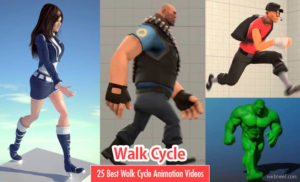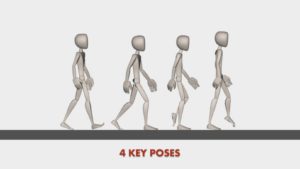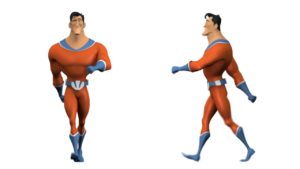Hello Readers, today in blog we will discuss about how to make Walk Cycle in Animation.
Walking is an important part of human body.
Walk Cycle Animation is about animating a normal walk.
It is one of the most important learning elements in animation.
Walk Cycle animation is difficult and it requires attention.
If one can master a walk cycle then he/she can animated just anything.
Walk Cycle is commonly used in video games, films and commercials.
There are many techniques and technology to create Walk Cycle.
Previously Walk-Cycles were hand drawn but with the advancement of the technology Walk Cycles can be made in 2D computer graphics, 3D and stop-motion.
A character takes two steps in 1 second (24 frames) in a Walk Cycle Animation.
The movement or animation to a human figure in computer graphics can be added though Walk Cycle.

In Walk Cycle Animation series of frames are drawn in sequences that looped to represent animation of a walking character.
Walk Cycle is looped to avoid animating each step again.
Every animator whether a beginner or an experienced needs to know how to create Walk Cycle.
At first the animator is required to study movement of the human body carefully.
Understand how a body moves during a walk, how the hand moves, how the leg moves and the body posture.
Make sure what sort of movement you would like to give to your character.
A slow motion can indicate that your character is sad or emotional while a fast motion means happiness and joy.
To create a Walk Cycle Animation in 3D software, the character requires good rig.
Make the knee and the elbow slightly bent; it will help during the animation.
Design a character to which you want to give movement, draw a simple character if you are creating a Walk Cycle for the first time.
Four Basic Poses

There are four main positions in a walk.
Contact Position
The first position is the contact position here the feet is contacting the ground and the weight of the body is divided between each leg.
Keep the leg slightly bend instead of making the leg perfectly straight.
Both feet are at the ground.
Down Position
In this position all the body weight is shifted onto the front leg.
The front leg is bended to catch all the weight.
Character’s full weight is shifted to the contacting foot.
This is the lowest position.
The back foot is slightly lifted; the toe is in contact with the ground.
Down Position comes between Contact and Passing Poses.
In Down Position compression of the whole body occurs.
Here the character is at the lowest point is vertical space; there is a bend in the knee on the planted foot.

Passing Position
Passing Pose is the important pose where one foot touches the ground while the other is lifted fully.
The weight of the character will go up for the passing position.
The weight is over the supporting foot.
Here the body weight of the character counter balances overtop of a foot which is flat on the ground; this protect us from falling as the other foot is in air.
Up Position
This is the last position of the Walk Cycle.
At this position the character is in his/her highest point of walk.
The leg is at the point of touching the ground.
The heel of the back foot is in the contact position.
In this position the grounded foot is pushing the character to the highest point in the walk; hips and spine are tilted back.
This is the basic four key poses for the Walk Cycle Animation; the artists need to draw the in-betweens once these four poses are drawn.
Add fine details to enhance the animation.
We have to repeat these basic four positions in order to create Walk Cycle in Animation.
Normal walking is a process of falling forward and we tend to be rotated slightly forward.
The faster a character moves the more it tend to rotate forward.
Other than the movement of the legs, many more details are also necessary such as animation timing, movement of the arms, head and the whole body.

Animating the Arms
Generally the arms swing back and forth opposite to the direction of the leg.
If the right leg is forward then the right arm is back; if the left leg is back the left arm forward.
This is related to the balancing and distribution of the body weight.
In human body limbs naturally counter-swings to keep the body on balance.
While walking the arms are straight in general so we don’t need to bend the arm.
To make a perfect walking animation one must pay attention to balance and rotation.
While making each step we have to change the centre of gravity to make sure that the character does not fall.

The upper part of the body also adds life and appeal to the walk.
A big, broad chest gives a feeling of attitude to the character.
Chest must have some rotation because if the arm is moving then chest can’t be perfectly still.
A character with broad chest looks dignified while walking.
Hip Movement
Hips also play an important role in the process of walking.
Both hip joints and pelvis move and rotate to bring balance to the character.
To get the proper weight of the character assume the character’s hip as a ball bouncing as it goes up and down.
Fixing the Knee Popping
Knee popping should be minimal, keep a slight bend in the knee while creating the contact position.
Take advantage of leg stretch control available on the rig to avoid the popping.
Stretch the leg slightly to get rid of the popping.
In case rig don’t have the stretch control then use the hip control to eliminate any popping.
Therefore in the above space we saw how we can create Walk Cycle Animation.
If you want to know more about this content then kindly contact us at MAAC Kolkata.




